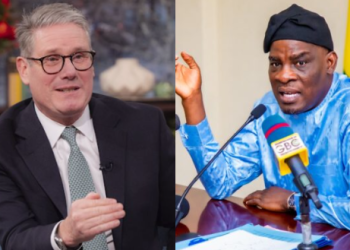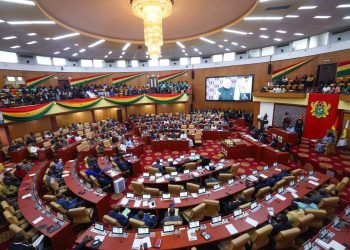The government has set an economic growth target of at least 4.8 per cent for 2026, underpinned by a total expenditure of GH¢357 billion (GH¢357,105,639,079.87).
This growth is expected to be driven by continued expansion in services, manufacturing, and agriculture, while non-oil GDP is projected to grow at 4.9%, reflecting the government’s commitment to diversifying the economy and reducing dependence on extractive sectors.
Inflation and fiscal discipline under control
Inflation is expected to remain under control, with an end-of-year target of 8.0 per cent, consolidating gains made in stabilising prices and easing the cost of living for households.
Finance Minister Dr. Cassiel Ato Forson announced these figures during the presentation of the 2026 Budget and Economic Policy Statement in Parliament.
He emphasised that fiscal discipline will remain a priority, with a primary surplus of 1.5% of Gross Domestic Product (GDP) on a commitment basis, while gross international reserves are projected to provide at least three months of import cover, ensuring external resilience and strengthening the defense of the Ghana cedi.
Fiscal and monetary outlook
Real GDP is anticipated to rise steadily, averaging around 4.9%, while non-oil GDP is programmed to grow by approximately 5 percent.
Inflation is projected to stay within the 8±2 per cent target band, reflecting a firm grip on price stability.
The fiscal balance is set to remain robust, with a primary surplus of 1.5% of GDP from 2026 onward, consistent with the amended Public Financial Management Act.
The overall fiscal deficit on a commitment basis is projected at 2.2 per cent of GDP, while the cash-basis deficit is expected at four per cent, accompanied by a primary cash deficit of 0.4 per cent of GDP.
Revenue mobilisation on the rise
Revenue mobilisation for 2026 is projected at GH¢268.1 billion, up from GH¢226.5 billion in 2025.
Non-oil tax revenue, which accounts for about 80.6% of total revenue, is estimated at GH¢216.1 billion, reflecting 18.8% annual growth.
Non-tax revenue (non-oil) is projected at GH¢20.9 billion, with GH¢18.2 billion retained by MDAs to support operations and GH¢2.8 billion lodged into the Consolidated Fund.
The Internally Generated Fund (IGF) Capping Policy is expected to yield an additional GH¢329.6 million.
Oil and gas receipts are projected at GH¢13.6 billion, while other revenue, including SSNIT transfers to the National Health Insurance Levy and Energy Sector Levies, is expected to reach GH¢14.4 billion.
Grants from development partners are projected at GH¢3.1 billion, equivalent to 1.1% of total revenue and grants, and are entirely project-related.
Planned expenditure and investments
Total expenditure on a commitment basis is programmed at GH¢302.5 billion, representing 18.9% of GDP, up 20.1% from the 2025 projection of GH¢251.7 billion.
Primary expenditure, excluding interest payments, is projected at GH¢244.7 billion (15.3 per cent of GDP).
Compensation of employees, covering wages, salaries, pensions, gratuities, and social security contributions, is projected at GH¢90.8 billion, reflecting a 9 per cent increase under the Single Spine Salary Structure.
Use of goods and services is projected at GH¢13.2 billion, while grants to other government units, including GETFund, NHIF, and DACF, are estimated at GH¢63.6 billion.
GH¢57.7bn interest payments
Interest payments are projected at GH¢57.7 billion, comprising GH¢50.1 billion domestic interest and GH¢7.6 billion external interest.
Capital expenditure is projected at GH¢57.5 billion, including GH¢45.5 billion domestically financed, with GH¢15.5 billion allocated to Ministries, Departments and Agencies (MDAs) and GH¢30 billion for the Big Push Infrastructure Programme, while foreign-financed capital expenditure is projected at GH¢12 billion. Other expenditures, including ESLA transfers and payments to Independent Power Producers, are estimated at GH¢19.7 billion.
Fiscal balance and financing
The overall fiscal balance on a commitment basis is projected at a deficit of GH¢34.4 billion (2.2% of GDP), with a corresponding primary surplus of GH¢23.3 billion (1.5% of GDP).
On a cash basis, the overall deficit is projected at GH¢64.2 billion (4 per cent of GDP), with a primary deficit of GH¢6.5 billion (0.4 per cent of GDP).
The cash deficit will be financed through a balanced mix of foreign and domestic borrowing.
Foreign financing is projected as a net repayment of GH¢6.6 billion, including expected disbursements from the IMF Extended Credit Facility (US$360 million), the World Bank Development Policy Operation, and bilateral support of US$313.2 million. Domestic financing is expected to amount to GH¢71 billion, primarily through issuances of long- and short-term government securities, supporting domestic market development, debt sustainability, and financial sector stability.
Strategic investments for growth
Dr Ato Forson said that through this fiscal strategy, the government aims to maintain discipline while ensuring productive investments, particularly under the Big Push Infrastructure Programme and other national priorities.
The 2026 budget reflects Ghana’s commitment to sustainable growth, fiscal prudence, and a resilient economy while safeguarding resources for strategic development initiatives.











